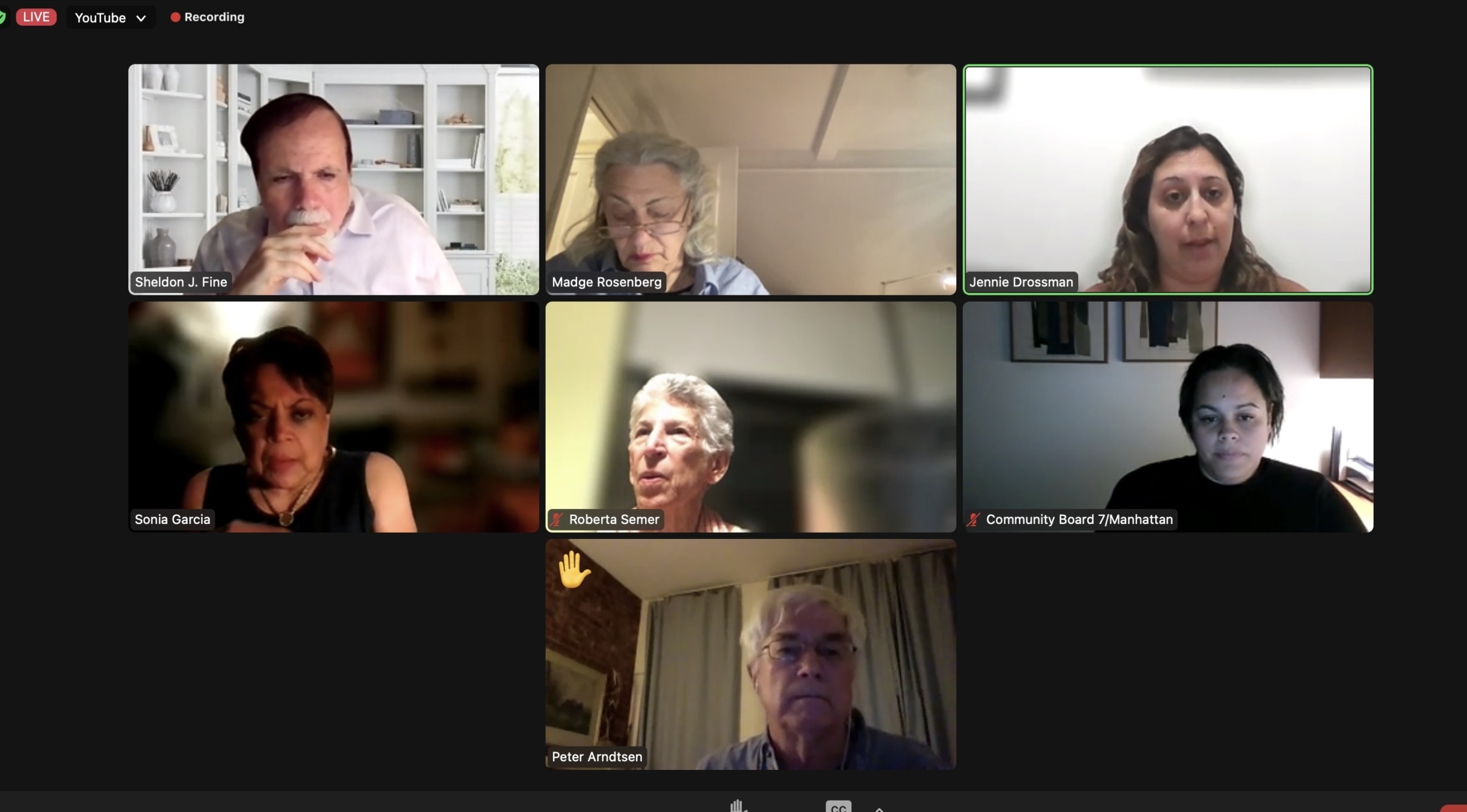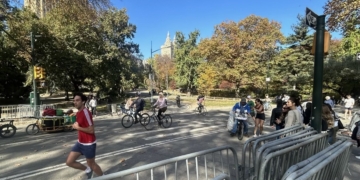
By Aditi Praveen Kariyanahalli
Experts on homelessness and mental illness outlined new city plans to combat both issues at a Community Board 7 Health & Human Services Committee meeting Tuesday night. Much of the discussion focused on the city’s Subway Safety Plan, released last month, which describes efforts to aid “those experiencing homelessness and those with severe mental illness” in city subways.
At the heart of the plan, the city is “really trying to connect people to these different services that are available,” said Dr. Michael McRae, executive deputy commissioner for mental hygiene at the city’s Department of Health and Mental Hygiene, “and making sure that you know there’s not a one-size-fits-all kind of solution here.”
Among the services McRae described to board members are community outreach teams that deploy clinicians to city subway stations, where they can immediately respond to mental health emergencies. In severe cases, said McRae, the clinicians can arrange a transfer to a hospital or clinic.
After McRae had left the meeting, CB7 board member Sheldon Fine said “I haven’t seen too much,” of the clinician teams McRae described. Turning to other board members, Fine asked: “Those who ride the subway, have you seen teams? Has anyone seen the teams? On the 1? The 2? The 3? The D? The C?” After receiving mostly head shakes from the rest of the board, Fine said. “I don’t know anyone who’s seen it.”
Other board members agreed with Fine, noting that while they have seen police officers and other law enforcement agents in subway stations, none had seen the clinician-led teams described by McRae.
Later in the meeting, Jennie Drossman, associate vice president of Street Solutions at Goddard Riverside Community Center, described the efforts of the Manhattan Outreach Coalition (MOC) to provide housing, medical care and mental health support to homeless people.
“We’re starting where the clients are comfortable,” said Drossman, describing how MOC would approach homeless New Yorkers and offer them housing, support, and other basic necessities. “The client is really the expert in their own life. Many have experienced trauma and bad experiences with institutions or the system in general. So we really look at it as one step at a time,” said Drossman. “And you have a lot of clients that… are [then] able to move on to transitional or permanent [housing] from there.”
At the end of the meeting, the board members discussed a possible resolution to call on the mayor and City Council to increase funding for community-based homeless outreach programs. Such aid is needed for the over “300,000 New Yorkers with severe mental illnesses,” said Fine. But other committee members said they wanted to wait for a report expected from McRae’s department, which will give statistical detail on the level of serious mental illness in New York and allow for a more accurate prediction of budget needs. No timeline was given for that report, but the board decided to take no action on a resolution.









What happened to the 1 Billion dollars De Blasio gave his wife, to address Mental Health?
You do realize that such programs need continued funding?
Furthermore, though the billion dollars you call attention was not well accounted for, no evidence has emerged that it was used for fraud. Nor has it yet provided Ms McCray with a very well paying job at a private foundation.
Famous last words. When $1 billion is purposefully not well accounted for, I’d love to know what purposes other than fraud are likely. And no, I don’t believe in benign neglect and incompetence when $1 billion is being managed. Not how the real world functions – let alone the NYC piggybank.
You can easily find a detailed line item accounting of the Thrive spending for each year online. Don’t believe everything you read in the NY Post. And the program was examined by then-Comptroller Scott Stringer, no friend of De Blasio’s. You can also easily find his report online. While he did make some suggestions and find some reporting shortcomings, true of any program that size, there were no major issues.
Stringer wasn’t exactly a watchdog for anything.
Per the Subway Safety Plan linked, many of the teams center around “hubs” – Grand Central, Fulton St, Penn Station, etc, and End of Line stations. Not likely to be seen around UWS. And it’s something like 30 teams, which can reach a lot of people, but once they are split between homeless support and mental illness support it is dozens of non-quick human interactions daily for all of them, and then the bureaucracy of getting people settled somewhere. Wish them well, but it is a tough gig, very one on one, very hard to offer continuity of care, very slow. Do call 311 or NYC WELL if you think someone needs help.
The only real answer is forced institutionalization. It’s uncomfortable, but there it is. So many severely mentally ill people are unable to care for themselves. Leaving them on the streets does not benefit them or anyone else.
I agree that forced institutionalization or the kind of support that was supposed to be a concomitant of the closing of mental hospitals over a 1/2 century ago must be considered. What else is incarceration but forced institutionalization when the severely mentally ill commit crimes? As for the ACLU, how can they justify living in gutters in one’s own excrement as an expression of freedom?
It is a commentary on the level of civilization when the most vulnerable amongst us–children, the elderly, the sick–and the mentally ill–are abandoned.
Sadly the ACLU is the first to step up and challenge this (look at California) – I say sadly because not Institutionalizing many of these individuals is crueler then just leaving them alone on the streets.
Totally agree. Some people are just not able to make decisions for themselves and be constructive members of society. This is often no fault of their own, but those who think they are helping these people by leaving them alone are really only hurting them. Enable trained professionals to make these decisions – I’m not arguing to just throw any mildly disturbed person into a facility. But as with many other issues, we have swung too far in the wrong direction.
And as I have said before, this should be a NY State or even national issue, not just an NYC issue. Many of these people have virtually no ties to NYC and can receive much better treatment elsewhere at a much more reasonable price. Resources are limited so let’s use them wisely.
Then you’ve got to be willing to pay to make institutions something other than the hellholes they routinely were in the institutionalization era. No easy task, and not a cheap one.
Agreed, Sarah, but just because it’s hard doesn’t mean it’s impossible. We can do it, just not in the middle of NYC. Let’s start small and see what actually works.
Bill Williams below talks about the large sums that the “homeless and mentally ill industrial complex” is paid. Would there be money for some decent facilities, in which some mentally ill people could be mandated to reside and receive care, if it were taken out of money that goes to agencies that are supposed to work with mentally ill people “in the community”? Maybe some institutionalizations could be funded in part by the patients’ Social Security, Medicaid, or such, as with some nursing home placements?
Agree. Kendra’s Law was passed for a reason
Kendra’s Law proscribes the circumstances in which a mentally ill person can be compelled, by court order, to enroll and partake in outpatient treatment— not compulsory inpatient institutionalization. There’s a time and place for both in my opinion. Neither are being utilized this day and age because of the individual’s rights trumping public safety. In truth it is not about rights – but about capacity. If you do not have capacity to take care of yourself, your rights to roam around the public realm are forfeited.
The ineptitude of current policy can be summed up in the comment above, “The client is really the expert in their own life.” How can people who have mental health and./or addiction issues and who are living on the streets be considered “expert in their own lives” when that “expertise” has led them to live on the streets? This is the type of PC platitude that hasn’t worked and will never work.
We also seem to be oblivious to the ongoing history surrounding this problem. The good intentions that came out of Geraldo’s reporting on the modern-day snakepit that was Willowbrook 50+ years ago along with court rulings gave us the current treatment protocols that were developed as a response and have proven flawed and inadequate over DECADES! 20 years ago it was Larry Hogue, a story that clearly elucidated every failing from the mental health system to the police to homeless policy and yet nothing has changed.
The concept of the “right to fail” (PBS Frontline: https://youtu.be/7B-okvAO1tM ) does not work. Integration into the community without exponentially more support has been proven not to work. So why are we doing the same thing over and over? Because the homeless and mentally ill industrial complex wants to maintain the status quo not for the benefit of patients but for the benefit of themselves and the millions and billions of dollars that they are paid..
It is time for a change and a completely new approach.
When they don’t get the results they want, rather than scrapping the system and starting anew, they say, “we needed more….hence the failure.” There’s no acknowledgement that they were wrong and the outcome a failure. How about they start doing some S-C-I-E-N-C-E and following the Data? Decades of these freebie rights have led many mentally ill people to jail. Why is it so hard for anyone to accept that some people cannot live independently and cannot socialize normally with other people in the public realm?
Completely agree. I have seen things on the streets of the Upper West Side that no one should ever see. The system as it is seems quite inhumane. A quagmire of why almost nothing can be done. Even though millions or billions has been thrown at it. Everyone loses.
I don’t understand how budget is being discussed if no specific actions and steps are outlined. So let’s say a billion is given, then what? More teams are out on the streets and subway talking to the mentally ill homeless? Hospitals WON’T keep them longer than a few days.
A possible solution:
Barracks with semi-private cubicles Upstate on a State land where they can roam in a large, contained area. Perhaps farm their own food for those who are capable and some recreational facilities with their own sanitation teams.
A professional staff available 24/7, and of course, security provided.
This would give them as decent a life as is possible given their condition. Release possibilities when one is stabilized and can live on their own, or with family/friends.
Different levels can be kept in separate barracks/areas. Actually, this would provide a country setting that many city people would enjoy under different conditions of course,
This would also be cheaper and a lot more humane than the present situation.